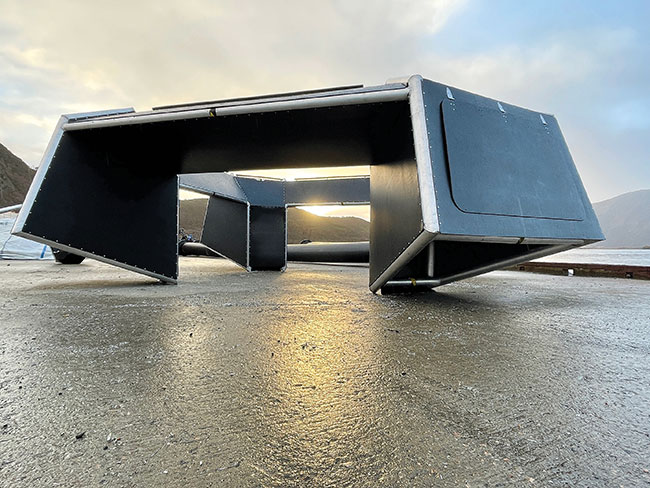
Potentially game-changing technology now on field trials
January 31, 2022
By
Liza Mayer
 When the fish rise to the surface to refill their airbladders, they are guided through the “sensor house” (pictured) where a sensor can quickly scan, recognize and record data on that specific fish using recognition data based on each fish’s unique markings and structure
When the fish rise to the surface to refill their airbladders, they are guided through the “sensor house” (pictured) where a sensor can quickly scan, recognize and record data on that specific fish using recognition data based on each fish’s unique markings and structure iFarm, a technology being developed in partnership between salmon producer Cermaq and technology company BioSort, is now being tested on a full scale at one of Cermaq’s sea sites in Vesterålen, Norway.
iFarm allows the individual monitoring of each fish for factors such as growth, sea lice, disease, lesions and others aspects that affect fish health and wellness.
The focus on the “individual” is key in the technology and is what makes it particularly unorthodox. Because only the sick fish is treated and not the entire stock, the cost of treatments and stress on the fish are dramatically reduced.
For the technology to work, each fish has to go to a chamber where a sensor can quickly scan, recognize and record data on that specific fish using recognition data based on each fish’s unique markings and structure.
The team behind the project followed the fish’s behavior in phase one of trials in the spring of last year and observed how they reacted to the presence of new equipment in their pens. They have incorporated learnings from that phase into the full-scale field trials now underway.

Diagram shows where the “sensor house” is positioned in the pen
“We are dependent on the fish choosing to swim through the sensor house, so in this (second) phase we are putting out six different sensor houses with different geometric designs, to test which houses the salmon prefer,” says iFarm project manager Karl Fredrik Ottem.
There are challenges, he noted: “Even though the fish seem to thrive and grow well, not everything runs completely smooth in such an innovative development project. With so much equipment down in the net pen, it has been demanding to find good solutions for both camera cleaning and equipment maintenance.”
The fish are kept 10 meters down in the net pen with iFarm and the team has observed fewer lice in that depth. “We reckon that we have saved a minimum of one de-licing operation on the iFarm fish during phase one at Martnesvika, even though we only have iFarm set-up in single net pens there,” says Ottem. “At Langøyhovden we have iFarm set-up in all the net pens, and it will be very interesting to see what effect it will have on lice levels eventually.”
Advertisement
- How aquaculture is restoring wild endangered Atlantic salmon species
- AquaBounty set to build new salmon farm in Ohio





